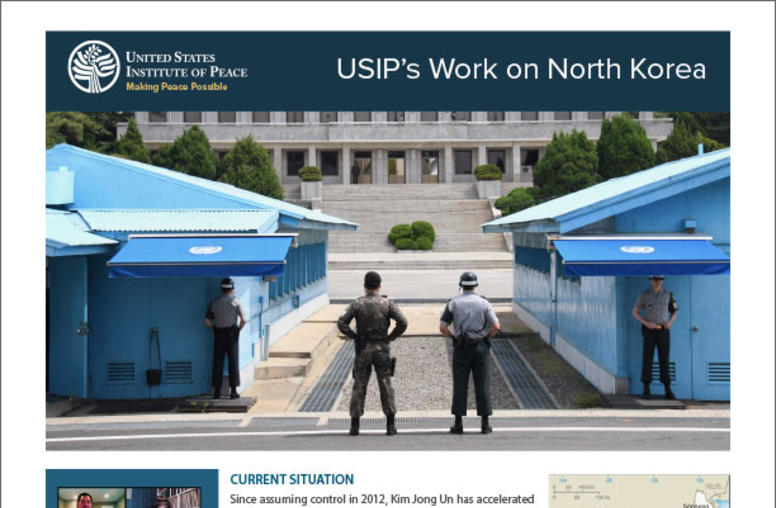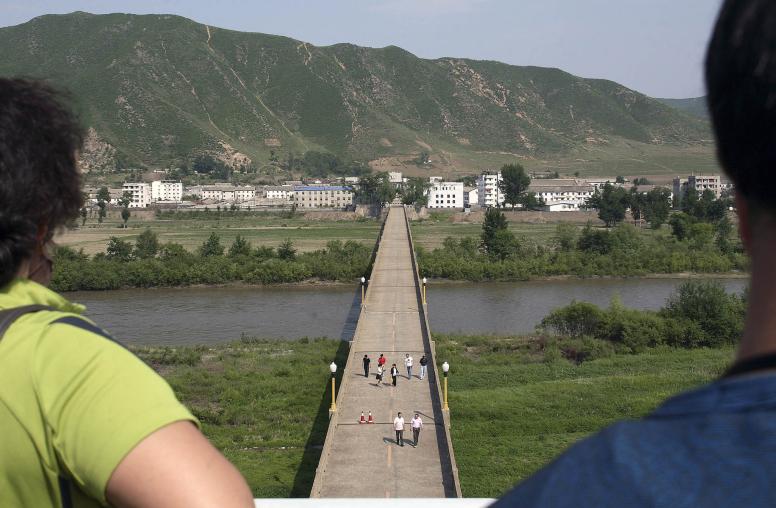U.S.-North Korea Negotiations: What Happened in Hanoi?
Washington and Pyongyang can’t agree on a deal, remain divided on what denuclearization means.
President Trump and North Korean leader Kim Jong Un unexpectedly cut short their second summit Thursday after failing to come to an agreement to dismantle Pyongyang’s nuclear weapons and provide sanctions relief. USIP’s Ambassador Joseph Yun and Frank Aum explain what happened in Hanoi and what comes next for U.S.-North Korea nuclear diplomacy.

Why was there no agreement in Hanoi between President Trump and Chairman Kim?
The negotiations broke down over what denuclearization steps Kim was willing to take and how much sanctions relief Trump was willing to provide. We may need the dust to settle before we get all the details, but there seems to be differing viewpoints on what happened.
Based on President Trump’s press conference, North Korea would agree to completely dismantle its nuclear facility at Yongbyon, but in return wanted the entire sanctions regime lifted, which President Trump wasn’t willing to accede to.
According to Foreign Minister Ri Yong Ho’s midnight press conference, however, North Korea only wanted relief from five United Nations Security Council (UNSC) resolutions from 2016 and 2017 in exchange for the complete dismantlement of the Yongbyon facility. But, President Trump added one more request unrelated to the Yongbyon nuclear facility that signaled that the U.S. wasn’t interested in the North Korean proposal.
It is unclear which five UNSC resolutions Foreign Minister Ri was referring to, but most likely they would have constituted a significant part of the sanctions regime against North Korea. It is also unclear what additional request President Trump made.
It appears that the president was willing to shoot for a “big deal” that would provide complete sanctions relief as well as other incentives such as an end-of-war declaration and exchange of liaison offices, but this would require complete denuclearization, including all nuclear facilities (not just Yongbyon), weapons, and materials. But both sides realized almost immediately that the gap in how each side values denuclearization and sanctions relief was much too wide.
What comes next in the diplomatic process?
A positive outcome is that the “dual freeze” on North Korean nuclear and missile tests and U.S.-South Korea military exercises, which helped create the peaceful environment for diplomacy to proceed, remains in place. President Trump conveyed that Chairman Kim agreed to continue to suspend nuclear and missile tests, and all but said that U.S.-ROK joint exercises will remain suspended or at least significantly modified.
Another silver lining from the Hanoi negotiations is the confirmation that the U.S. approach to North Korea embraces reciprocity and the simultaneous discussion of denuclearization and peace. The exact sequencing of concessions is a separate matter but there is less concern that Washington will demand that North Korea denuclearizes first before any steps can be taken on peace-related issues.
Still, both principals return home empty-handed and without a clear picture of what lies ahead.
From a process perspective, a significant letdown from the Hanoi summit was the lack of any roadmap or clarity on additional working-level negotiations. Although Trump indicated that Secretary Pompeo will continue meeting with his counterpart, there was no specificity about when these meetings would happen, whether Special Representative Steve Biegun would engage in regular working-level negotiations, and what the end goals would be in the next two years. Another concern is that if the two top decision makers, Trump and Kim, couldn’t agree on a deal, then what chance do lower-level officials, like Pompeo and North Korean spy chief Kim Yong Chul, or Biegun and chief nuclear negotiator Kim Hyok Chol, have of making progress?
The outcome could be an even bigger setback for Kim Jong Un. If North Korea really wants summit-level diplomacy, they should realize that Trump is not likely to agree to a future summit without an iron-clad guarantee of success.
The biggest disappointment from the Hanoi “no deal” is likely being felt by President Moon and South Korea. The lack of any sanctions relief will make it difficult, if not impossible, to conduct serious North-South economic engagement and move forward on cooperation projects like the Kaesong Industrial Complex and inter-Korean railways. Moreover, Chairman Kim’s visit to Seoul, which many thought imminent, now looks unlikely anytime soon since there will be no achievements to tout at the summit.
Were there any other interesting takeaways?
One of the biggest concerns among North Korea watchers has been the lack of a common definition between the two sides about denuclearization. President Trump acknowledged in the press conference that the two countries’ visions about denuclearization were not exactly the same, so it appears more work is needed on this topic.
Also, President Trump confirmed that there are other nuclear sites beyond Yongbyon that Washington is interested in, answering affirmatively about a second suspected uranium enrichment site. Most Korea watchers already knew about these additional sites, but it helps to have presidential-level confirmation that Yongbyon isn’t the only site of concern.



